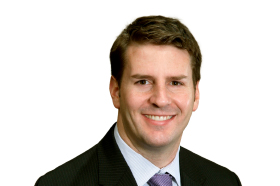Healthcare sector CFOs offer insights on properly setting priorities for success
Growing a healthcare organization in today’s macroeconomic environment involves balancing a number of competing needs, with workforce shortages and technology adoption among the most widespread and pressing. To address these needs, healthcare sector chief financial officers must ensure organizational solvency so that pursuing their healthcare systems goals isn’t hindered by a lack of financial support.
Because of this, healthcare CFOs must be part of any major healthcare organization initiative and have important perspectives to offer on organizational goals that, at first glance, may seem to be outside their purview. Grant Thornton’s CFO survey series has examined the input of these executives from a cross-section of industries, assessing and tabulating their views on business issues and providing insights on how they best drive strategy to deliver results for their businesses. In past research, we have assessed how CFO decisions drive profitability, how they support ESG strategies and what directions they consider to solve workforce issues.
We recently asked just more than 100 CFO leaders in the healthcare industry to participate in a 10-minute survey and offer their thought and priorities on what guides them in their decision-making at their organization. Grant Thornton Managing Director of Operations Transformation for Healthcare John Summerlin discusses some of the most significant results of the survey and provide insight on how expert money management can be the foundation of a stable and growth-oriented healthcare organization.
Growing through patient loyalty
Our healthcare CFO survey found that patient experience enhancement is the most important part of a healthcare CFO’s growth priorities, ranking ahead of expanding into new markets, launching new services, increasing community outreach and M&A activity.
Summerlin said understanding why “patient experience” is a top priority priority starts with realizing that growth in healthcare organizations, traditionally, is dependent on increasing volume—serving as many patients as you can. Growth occurs, Summerlin said, either through increasing the ability to see new patients within existing facilities or by enlarging the capacity of a healthcare system, either through acquisition or expansion.
However, in 2023, the ability to acquire more physicians or new locations has been curtailed by many factors: the pandemic had an impact, but also by more recent economic shocks like inflation and high interest rates. Growing through acquisition isn’t as viable as it was. Uncertainties about reimbursement models for healthcare such as Medicare funding and the Affordable Care Act create disincentives to the idea of just growing by acquiring more patients.
A more controlled way to grow, Summerlin said, is to better capture a patient’s entire needs within a particular healthcare organization. Patients who use a healthcare system for, say, their primary care physician need to perceive that there are reasons to seek other medical care in-system as well, such as lab work or specialist care or emergency care. This is particularly true in high-population regions that offer nearby healthcare system alternatives. Conceptually, this means investing in a “patient loyalty” model, Summerlin said.
“If I’m a hospital CFO, I want to make sure that from the second a patient touches my organization, her experience is such that it creates loyalty,” Summerlin said. “She should want to come to the system not just for primary care or physical therapy but as a provider for any of her healthcare needs.” Patient loyalty, then, can create growth without acquisitions or hiring more employees, a particularly problematic goal given the acute workforce shortages in the industry.
Our CFO survey for healthcare also asked for open-ended responses about decisions that drive growth, with terms like “patient,” “customers,” “better” and “need” cited frequently in the answers. The most common word, however, was “technology.” Summerlin said this wasn’t surprising, since besides access to healthcare, patients are becoming more like customers in a shopping experience, rather than passive actors. If you look at potential patients through that lens, that they are “consumers of healthcare products,” then healthcare organizations need to think about the customer experience of their patient/consumers. That naturally leads to a focus on how technology can improve that experience and bolster patient loyalty.
“Healthcare CFOs need to think about what technologies they can bring to bear to deliver the most seamless experience, to coordinate care and to ensure that when employees interact with patients—the customers—that happens as seamlessly and effectively as possible,” Summerlin said.
The value of forging partnerships
We asked healthcare CFOs to prioritize their company’s investment and growth opportunities, asking them to rank four priorities:
- Risk level of probability of success
- Strategic fit with company goals and mission
- ROI or payback period
- Market potential and growth opportunities
Respondents clearly favored market potential and strategic fit over risk level and return on investment, which could be interpreted as an optimistic outlook. Summerlin said that, historically, it was easier to acquire new capacity, move into new markets and start new service lines. But even those moves could be motivated by risk mitigation, such as better competing for market share with rival organizations, rather than taking advantage of opportunities.
“To me, the message I read in this reaction and response is an acknowledgement that the dynamics have changed,” Summerlin said. Growing just for its own sake isn’t a viable strategy for most, so the emphasis on market potential and strategic fit is an outgrowth of evaluating patient needs from a “customer” loyalty lens, and acting to fulfill those needs. Strategic growth in this way is, at times, a matter of being realistic about what your organization cannot do well and finding a nearby partner that does.
“I’ve had clients say it’s more cost-effective for me to find a good partner for dialysis or physical therapy or wound care and focus on the things we do well like, say, primary care or surgical care,” Summerlin said. Strategic alignments with niche players can relieve healthcare systems of the impulse to be “good at all things” and allow them to focus on their strongest abilities.
Our survey also asked specifically about collaboration in the market, with healthcare CFOs indicating their most likely collaboration partner were healthcare plans, closely followed by other healthcare providers, with private equity and retail market entrants tallying a distant third and fourth.
Summerlin said this answer can be interpreted by examining a growing trend of the past 10 to 20 years, value-based care. Even now, no single answer on how to successfully run a value-based care model has become predominant in the marketplace. Health plans, in response, have evolved to partner more directly with healthcare systems. In most U.S. markets, major commercial health plans now have “preferred relationships” with health systems, so this is a trend healthcare CFOs certainly see continuing.
Working in partnership with other health systems, Summerlin said, is not something that we’ve seen much of yet, but the dynamics of it are becoming clearer. Research into the health of populations, including how social determinants affect them, all point to how in some circumstances, the cooperation of competing health systems to ensure mutually beneficial outcomes can make a difference. Joint efforts on projects such as helping connect underserved communities to government programs or helping provide more access to better food can significantly improve overall health outcomes of a community, with better results for all.
Automation solutions
Workforce shortages plague most all healthcare organizations, so CFOs must be attuned to ways of managing expensive contract labor effectively to alleviate this burden. Hiring from staffing agencies has eased the shortages across the clinical spectrum but comes at the price of higher labor costs.
When asked about steps their organization is taking to mitigate these rising costs, CFOs most often cited implementing automation and other efficiency measures and reducing dependence on outside contracting most often.
Regarding outside contracting, Summerlin said most healthcare organizations have been part of a decades-long effort to hone job roles to make sure all employees are working at the top of their license — making sure nurses do work only nurses can do, physicians do work only physicians can do, and so on. The corollary to that effort is looking at what nurses and physicians do and asking questions like, “Can a nursing aide do a task instead of a nurse?” “Can a scribe write part of a report instead of a physician?”
By rethinking duties and parsing them out to non-licensed individuals who presumably would be easier to hire, nurses and physicians can spend more of their time performing more of what they are trained to do each day. This can reduce reliance on highly specialize, high-cost outside labor.
Prioritizing automation is just another way of reducing the cost of outside labor. Hospital CFOs can look at a nurse’s or a physician’s ancillary duties and find a system to automate those tasks. One of the effects of the pandemic on healthcare was to normalize the ability to automatically message providers. While this has added additional tasks to physicians and nurses, it has sometimes served as a substitute for an in-person visit, and thus becomes an overall time-saver. Other automated tasks such as routine prescription medicine refills or appointment changes shouldn’t need to through a physician or nurse, but straight to a pharmacy, Summerlin said.
“If a healthcare organization can use automation in any of its forms to triage all of those messages, making sure that those that are really important clinically land with a physician, it will have improved its workforce experience and its patient service,” Summerlin said.
Overall, Summerlin said CFOs looking at growth opportunities with a focus on addressing patients’ needs must be conscious that patients today are able to learn about, assess and evaluate a healthcare system’s performance in much more detail than even the recent past. “If going from market A to market B, there are patients in that market that can look at your record and determine whether a healthcare system is going to answer their needs before they use it,” Summerlin said. “It just becomes even more important to have information available about the great patient experience a healthcare system provides.”
Contact:



John Summerlin
Managing Director, Business Consulting
Grant Thornton Advisors LLC
John is a Managing Director in Grant Thornton's national Healthcare Advisory practice focused on Operations Transformation.
Atlanta, Georgia
Industries
- Healthcare
- Not-for-profit and Higher Education
Service Experience
- Advisory Services
- Business Consulting
Content disclaimer
This Grant Thornton Advisors LLC content provides information and comments on current issues and developments. It is not a comprehensive analysis of the subject matter covered. It is not, and should not be construed as, accounting, legal, tax, or professional advice provided by Grant Thornton Advisors LLC. All relevant facts and circumstances, including the pertinent authoritative literature, need to be considered to arrive at conclusions that comply with matters addressed in this content.
Grant Thornton Advisors LLC and its subsidiary entities are not licensed CPA firms.
For additional information on topics covered in this content, contact a Grant Thornton Advisors LLC professional.
Trending topics

No Results Found. Please search again using different keywords and/or filters.
Share with your network
Share